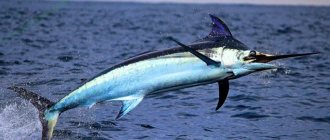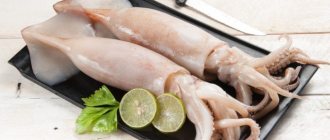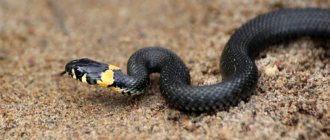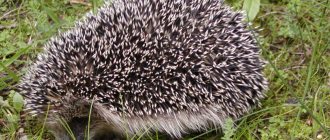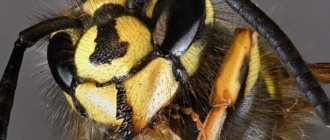- Wild animals
- >>
- Other animals
The cuttlefish is an amazing creature that can swim at tremendous speeds over short distances, instantly camouflage itself, confuse its predators with a flash of dirty ink, and delight its prey with an incredible display of visual hypnotism. Invertebrates make up 95% of all animals, and cephalopods are considered to be the most intelligent of all invertebrates in the world.
Appearance of animals
The cuttlefish has an oval, slightly flattened body. The mantle (skin-muscle sac) forms its main part. The inner shell acts as a skeleton, and this distinctive feature is characteristic only of cuttlefish. It consists of a plate with internal cavities that provide the cuttlefish with buoyancy. The shell is located inside the body and protects the internal organs.
The head and body of the mollusk are fused. The cuttlefish's eyes are very large and can zoom in, with the pupil controlling the intensity of the light. On the head of the cuttlefish there is something similar to a beak, with which the mollusk extracts and crushes food. And also, like numerous cephalopods, the cuttlefish has an ink sac. This is a special organ, which is a dense capsule divided into two parts. One part contains ready-made ink, and the other contains special cells saturated with special grains of paint. When mature, the cells are destroyed and ink is formed. The ink sac produces a huge amount of ink. An empty bag is restored on average in half an hour.
The most famous types:
- common cuttlefish;
- Pharaoh's;
- crucifying (the most beautiful and poisonous);
- broad-armed (largest);
- striped (very poisonous).
The mollusk has eight tentacles and two anterior palps. Each of them has small suction cups. The front tentacles are hidden in pockets under the eyes and are used to attack prey. Elongated fins are located on the sides of the body and help the cuttlefish when moving.
Reproduction
Breeding season
The species has a polyandrous mating system , meaning females can mate with multiple partners, often choosing males who demonstrate intelligence rather than physical strength or size. Mating rituals are complex, and since males outnumber females in most populations, the breeding season can involve lethal aggression between competing males. Mating behavior may also include color changes, bioluminescence, and even "sex reversal ," where males pose as females to avoid physical confrontation with other males.
Photo: Francis Nie
Cuttlefish mate face to face , using special organs for fertilization. During mating, the male brings a modified hand to transfer his genetic material to the female's buccal area. This is the part of the female's mouth that stores the male's spermatophores (sperm packaged in special containers) until she is ready to use them to fertilize her eggs. Because a female often mates with multiple partners, the male will sometimes spray water through his mantle funnel into the female's buccal region to wash away the spermatophores of other males, increasing the likelihood of passing on his genetic material.
Reproduction occurs in the spring , when the water is at an ideal temperature and food is found in abundance. Fertilization of eggs occurs externally. Females lay eggs and use the male's stored sperm to fertilize them. The eggs attach themselves to stable structures such as grass, rocks or coral.
Cubs development
Cuttlefish eggs typically measure 1.8 to 2 cm in diameter and take about 40 to 60 days from fertilization to hatching. Because the eggs are almost transparent, the young cuttlefish can be seen developing inside them.
Photo: ronigreer
Once hatched, the young are miniature versions of the adults, only a few millimeters long. Females usually do not return to laying sites, so young individuals become independent immediately after hatching. During the juvenile phase, they eat small crustaceans and plankton, grow rapidly and reach their full size and sexual maturity in the first winter, with females maturing later than males.
Description of cuttlefish, coloring
A characteristic feature of these mollusks is the ability to change the color of their body. The color of cuttlefish is unusually diverse. This is possible thanks to skin chromatophore cells. The change in body color occurs consciously; the chromatophores obey the brain. This process occurs instantly, and the impression is formed that everything happens automatically. Cuttlefish cells are filled with special pigments of different colors.
In terms of variety of colors, complexity of patterns and speed of color changes, the mollusk has no equal. Certain species of cuttlefish are capable of luminescence. Color changes are used for camouflage. Patterns of different shapes carry certain information for relatives. The cuttlefish is one of the most intelligent species of invertebrates.
Further reading[edit]
- Fluckiger, M.; Jackson, J.D.; Nichols, P.; Virtue, P.; Daw, A.; Wotherspoon, S. (2008). "An experimental study of the effects of diet on the fatty acid profiles of European cuttlefish (Sepia officinalis)". Mar. Biol. 154
(2):363–372. DOI: 10.1007/s00227-008-0932-0. S2CID 85069548. - Hanlon, R. T.; Messenger, J. B. (1988). "Adaptive coloration of juvenile cuttlefish (Sepia officinalis L.): morphology and development of body patterns and their relation to behavior". Phil.
Per. R. Soc. B. _
320
(1200): 437–487. Bibcode: 1988RSPTB.320..437H. DOI: 10.1098/rstb.1988.0087. JSTOR 2396667. - Gibson-Hall, E.; Wilson, E. (2018). "Common cuttlefish (Sepia officinalis)". Marine Life Information Network
.
Area
Where does cuttlefish live? And it lives only in shallow waters, in tropical and subtropical seas that wash the shores of Africa and Eurasia. However, the striped cuttlefish has also been found off the coast of Australia. Mollusks prefer to live alone, occasionally in small groups, and only during the breeding season do large aggregations of cuttlefish form. During the mating season, they can move around, but, as a rule, lead a sedentary life.
Clams swim shallowly and stick to the shoreline. Seeing prey, cuttlefish freeze for a second, and then quickly overtake the victim. When danger arises, the mollusks lie to the bottom and try to cover themselves with sand with their fins. The cuttlefish is a very cautious and timid mollusk.
Where to hide
An octopus can fit through any crevice as long as its “brain,” the central nerve ganglion surrounding the esophagus, fits through. By the way, this nerve center is protected by a cartilaginous “skull” - none of the other invertebrates have cartilage. One day, a large blue octopus underwater was running away from us with all its legs, that is, all its tentacles, and it was right, because in Bali it is a desirable prey for fishermen, so people are always a threat. He climbed into some grotto, we lost him. And suddenly he comes out from the other side, all covered with shrimps - it turns out that he ended up in their shelter!
Unfortunately, amateur divers have limited time underwater; there is simply no time to observe the behavior of these shy creatures. When films with octopuses are filmed underwater, they are usually trained on site, and it takes very little time. So you have to believe the experts who believe that octopuses are the most intelligent invertebrates in the world. Perhaps their intelligence has developed during evolution because with the help of tentacles they can freely manipulate various objects. This ability to manipulate is necessarily associated with the general development of the brain, as happened, for example, in monkeys and elephants. Not all octopus arms are the same: they have a “favorite” hand, with which they perform almost all actions, like most people - with their right hand. The remaining arms are used more for movement; Octopuses are poor swimmers, and often, when moving with the help of a jet stream, they help themselves with tentacles.
Home is a very important concept for an octopus; he would rather allow himself to be pulled to the surface along with his home (for example, an ancient amphora) than leave it. A house can be a large shell, an empty bottle, or a grotto in a reef. There is also a coconut octopus Amphioctopus marginatus
, who carries his house everywhere - a coconut shell or a large bivalve shell (the shell is much easier to carry). If there is no natural shelter, then the octopus will build it from available material, stones or shells, and there will certainly be walls and a roof. Often, in front of the entrance to the house there are shells or fragments that the octopus sorts through with its tentacles. This is how underwater archaeologist Yu. G. Drobyshevsky describes his first meeting with this animal in the Aegean Sea: “The octopus looked at me from its shelter among the stones. Leaning out slightly from behind the stone, he stuck a fragment of an amphora to his tentacles and covered himself with it from above, like an umbrella.”
Common octopus, Octopus vulgaris
, are widespread in the Mediterranean Sea and other seas of the Atlantic Ocean. They are not as bright as tropical species; their usual color is brown. Underwater archaeologists often encounter them on ancient shipwrecks, where they inhabit ancient ceramic vessels. Scientists, in order not to offend them, are carrying out a kind of renovation - exchanging amphorae for completely modern glass jars.
Cuttlefish nutrition
From time to time, large individuals are able to eat smaller counterparts. This is not due to an aggressive nature, but more due to food indiscriminateness.
Shellfish eat almost anything that moves and does not exceed their own size. They feed on fish, crabs, shrimp, and shellfish. The cuttlefish blows a stream of water into the sand from the siphon, thereby raising it, and at this time the mollusk swallows small animals and cuts up larger ones with its beak. It will not be difficult for a cuttlefish to bite through the shell of a crab or the skull of a small fish.
Origin
Cuttlefish, along with octopuses and squid, are animals from an ancient branch of cephalopods that have inhabited the oceans for more than 500 million years . Cuttlefish originated in sea waters long before the first shark or fish appeared. Their ancestors were encased in a shell that served as protection from predators, but modern cuttlefish have developed an even better defense - camouflage.
Photo: Daily Mail
Reproduction
The cuttlefish is an animal that reproduces only once. Mollusks migrate to comfortable places for laying eggs, forming schools of several thousand individuals along the way. Communication occurs by changing body color. With mutual sympathy, both mollusks glow with bright colors. Cuttlefish eggs are mostly black and resemble grapes. After laying eggs, adult cuttlefish die. Cephalopods are born already formed. From birth, small cuttlefish are able to use ink. Cuttlefish live on average 1–2 years.
Conservation and Threat Status
Scientists do not have enough information to fully assess population trends for all cuttlefish species, but the International Union for Conservation of Nature (IUCN) lists them as a species of least concern .
Although no species of cuttlefish are currently endangered, increased harvesting of cephalopods in many countries may pose a serious threat to them in the future. Changes in the aquatic environment also pose threats to cuttlefish, including climate change, habitat loss, sea and ocean acidification, and chemical and physical pollution.
Nutritional value of shellfish meat
Cuttlefish is a source of excellent meat, which contains valuable unsaturated acids - eicosapentaenoic and docosahexaenoic acids, which protect against many diseases of the cardiovascular system. These elements also reduce the level of triglycerides in the blood, preventing the formation of blood clots and blockage of arteries.
Cuttlefish meat contains vitamins B2, B12, A, nicotinic and folic acids. In addition, shellfish meat is rich in minerals. In addition to useful substances, meat contains impurities such as cadmium and mercury. Nutritionists recommend eating no more than two servings per week.
Useful properties of ink
- Improves mood and fights emotional problems.
- Helps in the treatment of reproductive diseases.
- Eliminate symptoms of digestive disorders.
- Helps in the treatment of skin diseases.
In ancient times, ink liquid was used for writing. Cuttlefish ink is included in medicines. This substance has a calming effect.
The ink is used in the production of food coloring and seasonings. They give dishes a special black color and an excellent salty taste. Ready-to-use ink is sold in stores. Ink is also used to make sauces that have a bright and unique taste. Cuttlefish ink contains elements that help metabolism and have anti-inflammatory effects.
Lifespan and predation
Cuttlefish are short-lived, with a maximum lifespan of one or two years depending on the variety. Individuals kept in captivity have a longer life expectancy.
Natural predators of cuttlefish include dolphins, sharks, large fish, seals, seabirds and other cuttlefish. People also hunt them.
Cuttlefish is rich in calcium and is often sold in pet stores as a dietary supplement for poultry.
Interesting facts about cephalopods
- The cuttlefish has three hearts. Two hearts are used to pump blood to the gills, and the third is used to circulate oxygenated blood to the rest of the body.
- The blood of cuttlefish contains a protein called hemocyanin, which is used to carry oxygen. That's why her blood is blue-green.
- Cuttlefish is a mollusk that can imitate the shape and texture of surrounding objects. The mollusk changes its color by expanding or retracting small tubercles located throughout its body, thanks to which it practically merges with sand, cobblestones and other surfaces.
- Males, in order to court the female and not attract the attention of others, repaint themselves in an interesting camouflage. They paint one half of the body with colorful paint, and camouflage the other half as females, imitating muted tones.
- Cuttlefish can see well in low light conditions, as well as what is behind them.
- Cuttlefish are able to imitate the dynamic movements of algae on their bodies to become invisible. Or they organize a color show to catch prey.
- Mollusks skillfully defend themselves from enemies, but their relatively low rate of movement makes them vulnerable to their pursuers: dolphins and sharks.
Cuttlefish is also an interesting object for aquarists. However, keeping them is not easy because the mollusks are very shy, often releasing ink into the water, and it becomes opaque. After a certain amount of time, the cuttlefish gets used to the owner and ceases to be afraid of him.
Links[edit]
- Jump up
↑ Barratt, I. & Allcock, L. (2012).
"Sepia officinalis". IUCN Red List of Threatened Species
.
2012
: e.T162664A939991. DOI: 10.2305/IUCN.UK.2012-1.RLTS.T162664A939991.en. Retrieved February 6, 2020. - ^ a b c Compton, A; Wiley, L. "Sepia officinalis". Animal Diversity Network
. Retrieved March 20, 2022. - Reed, A. P. Jereb, and C. F. E. Roper 2005. Family Sepiidae. In:
P. Jereb and CFE Roper, eds.
Cephalopods of the world.
An annotated and illustrated catalog of currently known species. Volume 1. Kamchat nautiluses and sepioids (Nautilidae, Sepiidae, Sepiolidae, Sepiadariidae, Idiosepiidae and Spirulidae) . FAO Catalog of Fishery Species. No. 4, T. 1. Rome, FAO. pp. 57–152. - ↑
Roper CFE, MJ Sweeney & C E Nauen 1984.
Cephalopods of the world
. Food and Agriculture Organization, Rome, Italy. Vol. 3, p. 277. - ^ abc "Sepia officinalis, Cuttlefish vulgaris - Cephalopods Page". www.thecephalopodpage.org
. Retrieved March 20, 2022. - "Sepia officinalis". Animal Diversity Network
. Retrieved March 20, 2022. - Darmailak, Anne-Sophie; Lesimple, Clémence; Dickel, Ludovic (2008). "Embryonic visual learning in the cuttlefish Sepia officinalis
".
Animal behavior
.
76
: 131–134. DOI: 10.1016/j.anbehav.2008.02.006. S2CID 53147763. - ↑
Walker, M. 2008. Cuttlefish target prey early.
BBC News
, 5 June 2008 - Mäthger, L.M.; Jiao, SS; Barbosa, A.; Hanlon, R. T. (March 2008). "Color selection of natural substrates in cuttlefish, Sepia officinalis." Journal of Comparative Physiology
.
194
(6):577–585. DOI: 10.1007/s00359-008-0332-4. PMID 18414874. S2CID 25111630. - Kelman, E. J.; Baddeley, R. J.; Shohet, A.J.; Osorio, D. (2007). "Perception of visual texture and expression of destructive camouflage by the cuttlefish Sepia officinalis". Proceedings of the Royal Society of London B: Biological Sciences
.
274
(1616):1369–1375. DOI: 10.1098/rspb.2007.0240. PMC 2176201. PMID 17389219. - Hanlon, R. T.; Messenger, J. B. (1988). "Adaptive coloration of juvenile cuttlefish (Sepia officinalis L.): morphology and body development and their relation to behavior". Philosophical Transactions of the Royal Society
B.
320
(1200): 437–487. Bibcode: 1988RSPTB.320..437H. DOI: 10.1098/rstb.1988.0087. - ^ ab "Sepia officinalis (cuttlefish)". IUCN Red List of Threatened Species
. Retrieved March 21, 2022. URL of old form - Sund P (2017). “Does my bird really need cuttlefish?” .
- Sykes, A. W.; Oliveira, AR; Dominguez, P.M. Cardoso, C.M.; Andrade, J.P.; Nunez, M. L. (2009). "Evaluation of nutritional value and freshness of European cuttlefish (Sepia officinalis, L.) under ice storage conditions using the developed quality index method (QIM) and biochemical methods." LWT - Food Science and Technology
.
42
: 424–432. DOI: 10.1016/j.lwt.2008.05.010. - ^ ab Derby, Charles D. (12 May 2014). "Cephalopod ink: production, chemistry, functions and applications". Marine preparations
.
12
(5): 2700–2730. DOI: 10.3390/md12052700. PMC 4052311. PMID 24824020. - Current classification of modern cephalopods
- Adam, W. & W. J. Fig. 1966. Review of the cephalopod family Sepiidae. John Murray Expedition 1933-34, Scientific Reports 11
(1): 1-165, 46 plates.
